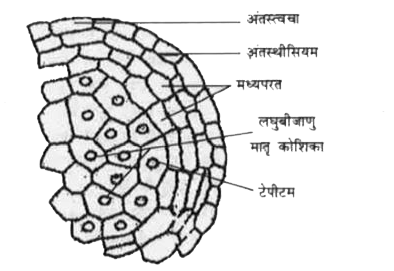Explain the structure of a typical long bone.Solution in Tamil
A typical long bone has a diaphysis, epiphyses and membranes. A tubular diaphysis or shaft, forms the long axis of the bone. It is constructed of a thick collar of compact bone that surrounds a central medullary cavity or marrow cavity. The epiphyses are the bone ends. Compact bone forms the exterior of epiphyses and their interior contains spongy bone with red marrow. The region where the diaphysis and epiphyses meet is called the metaphysis. The external surface of the entire bone except the joint surface is covered by a double-layered membrane called the periosteum. The outer fibrous layer is dense irregular connective tissue. The inner osteogenic layer consists of osteoblasts (bone- forming cells) which secrete bone matrix elements and osteoclasts (bone destroying cells). In addition, there are primitive stem cells, osteogenic cells, that give rise to the osteoblasts. The periosteum is richly supplied with nerve fibres, lymphatic vessels and blood vessels. Internal bone surfaces are covered with a delicate connective tissue membrane called the endosteum. The endosteum covers the trabeculae of spongy bone and lines the canals that pass through the compact bone. It also contains both osteoblasts and osteoclasts. Between the epiphysis and diaphysis epiphyseal plate or growth plate is present.
Topper's Solved these Questions
- BOOK - FULL MARKSCHAPTER - LOCOMOTION AND MOVEMENT EXERCISE - Additional Questions Solved (Short Answer Questions)27videos
LOCOMOTION AND MOVEMENT
- BOOK - FULL MARKSCHAPTER - LIVING WORLD EXERCISE - ADDITIONAL QUESTIONS SOLVED - HIGHER ORDER THINKING SKILLS (HOTS)16videos
LIVING WORLD
- BOOK - FULL MARKSCHAPTER - MINERAL NUTRITIONEXERCISE - ADDITIONAL QUESTIONS SOLVED - MULTIPLE CHOICE QUESTIONS5videos
MINERAL NUTRITION
Similar Questions
What is amoeboid movement ?
04:53View SolutionViruses and viroids are infectious particles. How do you differentiate one from other?
03:25View SolutionCarnivorous plants like Nepenthes and Venus fly trap have nutritional adaptation. Which nutrients do they especially obtain and from where?
02:06View SolutionExplain the structure of a typical dicotyledonous seed with a neat labelled diagram.
02:05View Solutionएक प्रारूपिक आवृतबीजी लघुबीजाणु धानी की संरचना का सचित्र वर्णन करें। साथ ही साथ प्रत्येक भाग के कार्य को बताएँ।
 02:15View Solution
02:15View Solutionबीजाण्ड की संरचना का सचित्र वर्णन कीजिए।
View SolutionExplain the structure of typical angiospermic ovule.
05:37View SolutionExplain the structure of a typical flower.
04:59View SolutionHaversian system is typically found in bones of
00:57View Solutionलम्बी अस्थि के संधितल पर उपस्थित उपास्थि है :
02:37View SolutionExplain histological structure of mammalian bone.
01:11:12View SolutionExplain the structure of bone and cartilage of man.
05:16View Solution"Growth of long bones are bidirectinal" -Explain.
View SolutionBone || Types OF Bone || Structure OF Long Bone (Haversian System)
02:15View SolutionExplain the structure of a typical antibody molecule.
02:37View Solution

